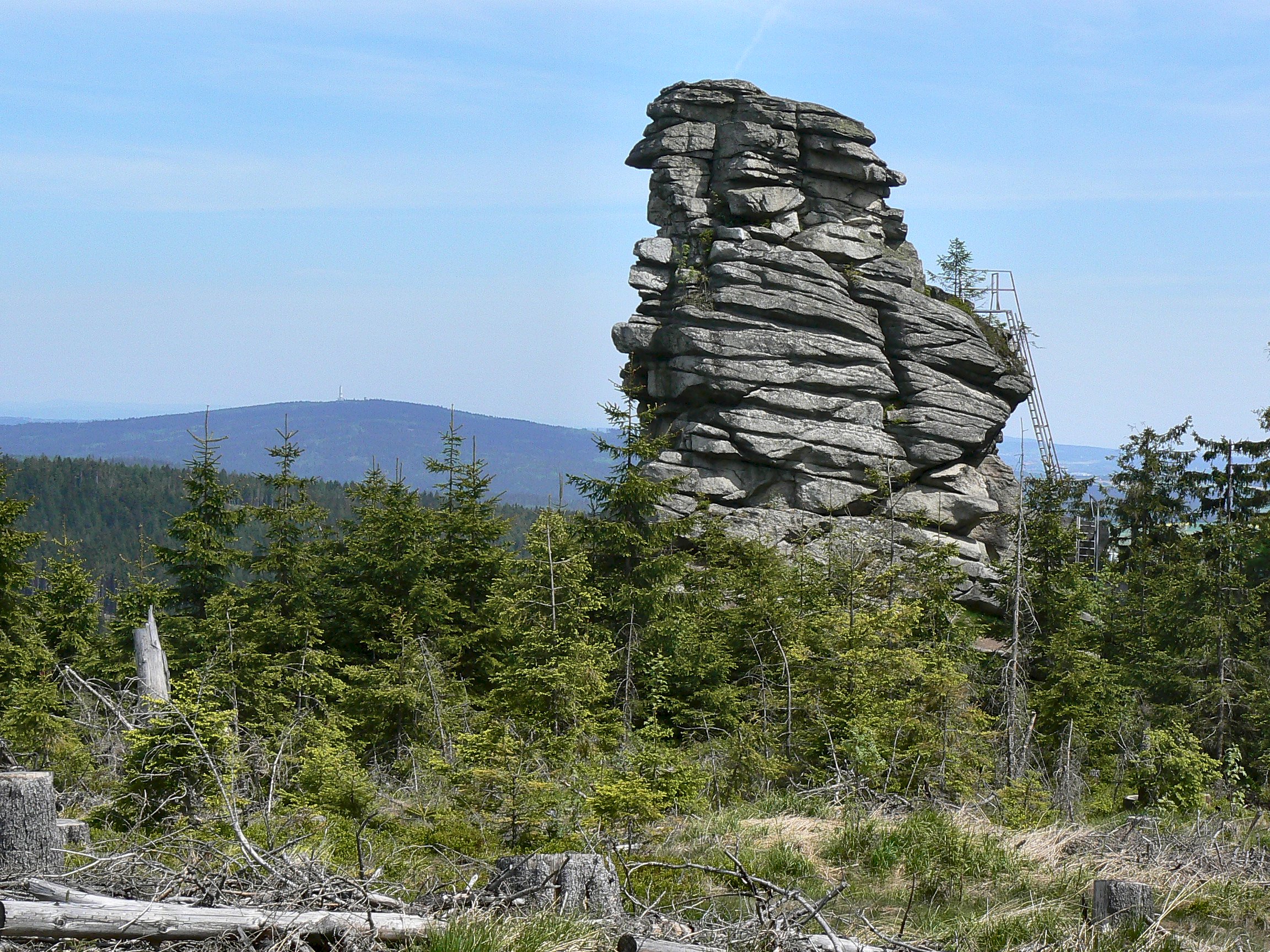|
Großer Waldstein
The Großer Waldstein is part of the Waldstein range in the Fichtel Mountains of Germany. It is known primarily for its rock formations caused by spheroidal weathering, its ruined castles and the only remaining bear trap (''Bärenfang'') in the region. Location and description The Großer Waldstein () is a mountain in the northern part of the Fichtel Mountain Horseshoe. Its summit area is covered by mixed forest with old stands of beech and huge rock piles, and the whole area is a designated nature reserve (). Marked hiking trails lead from all points of the compass to the mountain, and public roads run from Weißenstadt or Sparneck to the area of the summit. At the top is a lodging house owned by the Fichtelgebirge Club, the ''Waldsteinhaus'', from which there is an interesting walk around the summit area. The Jean Paul Way also crosses the Großer Waldstein. The Kleiner Waldstein and Hoher Stein are other rock formations on the Bergkopf. At the Großer Wal ... [...More Info...] [...Related Items...] OR: [Wikipedia] [Google] [Baidu] |
Fichtel Mountains
The Fichtel MountainsRandlesome, C. et al. (2011). ''Business Cultures in Europe'', 2nd ed., Routledge, Abingdon and New York, p. 52. . (german: Fichtelgebirge, cs, Smrčiny), form a small horseshoe-shaped mountain range in northeastern Bavaria, Germany. They extend from the valley of the Red Main River to the Czech border, a few foothills spilling over into the Czech Republic. They continue in a northeasterly direction as the Elster Mountains, and in a southeasterly direction as the Upper Palatine Forest. The Fichtel Mountains contain an important nature park, the Fichtel Mountain Nature Park, with an area of . Etymology The first person to write about the Fichtel Mountains, Matthias of Kemnath (actually Matthias Widmann, born 23 February 1429 in Kemnath) reported in 1476: ''Ein bergk, hoch, weitt, wolbekant ligt in Beiern, gnant der Fichtelberg'' ("A mountain, high, wide and well-known, lies in Bavaria, known as the Fichtelberg"). In descriptions of the border in 1499 and 15 ... [...More Info...] [...Related Items...] OR: [Wikipedia] [Google] [Baidu] |
Sparneck
Sparneck is a municipality in Upper Franconia in the district of Hof in Bavaria in Germany. Location The market town of Sparneck lies at an average height of in the Pfarrbach valley, which forms the larger part of the area. The Saxon Saale river flows through this valley in a northerly direction. Towards the east the 877 metre high Waldstein ridge rises, the source of the Saale is on its slopes. It forms the natural boundary with the neighbouring district of Wunsiedel (; Northern Bavarian: ''Wåuṉsieḏl'' or ''Wousigl'') is the seat of the Upper Franconian district of in northeast Bavaria, Germany. The town is the birthplace of poet Jean Paul. It also became known for its annual Festival and the Rudol .... History Sparneck is first mentioned 1223 with a person from Sparneck family. References Hof (district) {{Hofdistrict-geo-stub ... [...More Info...] [...Related Items...] OR: [Wikipedia] [Google] [Baidu] |
Romanesque Architecture
Romanesque architecture is an architectural style of medieval Europe characterized by semi-circular arches. There is no consensus for the beginning date of the Romanesque style, with proposals ranging from the 6th to the 11th century, this later date being the most commonly held. In the 12th century it developed into the Gothic style, marked by pointed arches. Examples of Romanesque architecture can be found across the continent, making it the first pan-European architectural style since Imperial Roman architecture. The Romanesque style in England and Sicily is traditionally referred to as Norman architecture. Combining features of ancient Roman and Byzantine buildings and other local traditions, Romanesque architecture is known by its massive quality, thick walls, round arches, sturdy pillars, barrel vaults, large towers and decorative arcading. Each building has clearly defined forms, frequently of very regular, symmetrical plan; the overall appearance is one of simplic ... [...More Info...] [...Related Items...] OR: [Wikipedia] [Google] [Baidu] |
Swabian League
The Swabian League (''Schwäbischer Bund'') was a mutual defence and peace keeping association of Imperial State, Imperial Estates – free Imperial cities, prelates, principalities and knights – principally in the territory of the early medieval stem duchy of Duchy of Swabia, Swabia established on 14 February 1488. The religious revolution of the Protestant Reformation divided its members, and the Swabian League disbanded in 1534. History The Swabian League was established in 1488 at the behest of Emperor Frederick III, Holy Roman Emperor, Frederick III of Habsburg and supported as well by Bertold von Henneberg-Römhild, Bertold von Henneberg-Römhild, archbishop of Mainz, whose conciliar rather than monarchic view of the ''Reich'' often put him at odds with Frederick's successor Maximilian I, Holy Roman Emperor, Maximilian. The Swabian League cooperated towards the keeping of the imperial peace and at least in the beginning curbing the expansionist History of Bavaria, Bavaria ... [...More Info...] [...Related Items...] OR: [Wikipedia] [Google] [Baidu] |
House Of Sparneck
The House of Sparneck was a local noble family in Franconia. The family is known to exist from 1223 to 1744 and was named after the market village of Sparneck. One of their first castles was the Waldsteinburg; further castles were located in Sparneck, Weißdorf, Stockenroth, Uprode near Weißdorf, Stein near Gefrees, Hallerstein (now part of Schwarzenbach an der Saale) and Gattendorf. Their homeland corresponds to the old district of Münchberg, now part of the district of Hof. The family is directly related to the Houses of Bibra, Gravenreuth, Guttenberg, Kotzau, Künsberg, Notthafft, Pappenheim, Reitzenstein and Zedtwitz. As a consequence of supporting the robber baron Thomas von Absberg, they were forced to give up their origin lands and moved to Upper Palatinate, keeping only few fiefs, the so-called ''Afterlehen'', e.g. in Bernstein near Wunsiedel and Dörflas, now a part of Marktredwitz. For two generations they can be found in Libá. At last they owned manor ho ... [...More Info...] [...Related Items...] OR: [Wikipedia] [Google] [Baidu] |
Spanish War Of Succession
Spanish might refer to: * Items from or related to Spain: **Spaniards are a nation and ethnic group indigenous to Spain **Spanish language, spoken in Spain and many Latin American countries **Spanish cuisine Other places * Spanish, Ontario, Canada * Spanish River (other), the name of several rivers * Spanish Town, Jamaica Other uses * John J. Spanish (1922–2019), American politician * "Spanish" (song), a single by Craig David, 2003 See also * * * Español (other) * Spain (other) * España (other) * Espanola (other) * Hispania, the Roman and Greek name for the Iberian Peninsula * Hispanic, the people, nations, and cultures that have a historical link to Spain * Hispanic (other) * Hispanism * Spain (other) * National and regional identity in Spain * Culture of Spain * Spanish Fort (other) Spanish Fort or Old Spanish Fort may refer to: United States * Spanish Fort, Alabama, a city * Spanish Fort (Colorad ... [...More Info...] [...Related Items...] OR: [Wikipedia] [Google] [Baidu] |
Zell Im Fichtelgebirge
Zell im Fichtelgebirge, formerly Zell (official name until July 2007) is a market town in the district of Hof in Bavaria in Germany. Geography The heart of the market parish lies between the towns of Hof and Bayreuth, about 5 km from the B 2 federal road and about 10 km from the A 9 motorway. The River Saale rises on the Waldstein ridge in the Fichtelgebirge The Fichtel MountainsRandlesome, C. et al. (2011). ''Business Cultures in Europe'', 2nd ed., Routledge, Abingdon and New York, p. 52. . (german: Fichtelgebirge, cs, Smrčiny), form a small horseshoe-shaped mountain range in northeastern Bavaria ... near Zell im Fichtelgebirge. The surrounding area may explored on some 30 kilometres of signposted hiking trails. References Hof (district) {{Hofdistrict-geo-stub ... [...More Info...] [...Related Items...] OR: [Wikipedia] [Google] [Baidu] |
Saale
The Saale (), also known as the Saxon Saale (german: Sächsische Saale) and Thuringian Saale (german: Thüringische Saale), is a river in Germany and a left-bank tributary of the Elbe. It is not to be confused with the smaller Fränkische Saale, Franconian Saale, a right-bank tributary of the Main (river), Main, or the Saale (Leine), Saale in Lower Saxony, a tributary of the Leine. Etymology The name ''Saale'' comes from the Proto-Indo-European language, Proto-Indo-European root wikt:Reconstruction:Proto-Indo-European/sélos, *''séles'' 'marsh', akin to Welsh language, Welsh ''hêl, heledd'' 'river meadow', Cornish language, Cornish ''heyl'' 'estuary', Ancient Greek, Greek ''hélos'' 'marsh, meadow', Sanskrit ''sáras'' 'lake, pond', Sarasvati River, ''Sárasvati'' 'sacred river', Old Persian ''Harauvati'' 'Harut River, Hārūt River; Arachosia', Avestan ''Haraxvatī'', idem. It may also be related to the Indo-European root *''sal'', "salt". The Slavic name of the Saale, ''Sola ... [...More Info...] [...Related Items...] OR: [Wikipedia] [Google] [Baidu] |
Bergkopf
The Bergkopf is an 857 metre high, thickly forested mountain in the Sparneck Forest in Germany's Fichtel Mountains. It lies in the northern chain of the Fichtel Mountain Horseshoe, near the crest of the Großer Waldstein. On its northern slopes is the granite rock formation of Kleiner Waldstein (), and, further north towards Sparneck, the source of the Förmitz river. To the northeast lies the granite mountain of Hoher Stein () and, on its slopes, is the source of the Lamitz. To the southwest towards Weißenstadt, a monument commemorates the forester, Johann Braun, who died at that spot on 12 July 1881. Literature * Dietmar Herrmann: ''Lexikon Fichtelgebirge - Bayerisches Vorgtland, Steinwald, Bayreuther Land''. Ackermann Verlag. Hof, 2000. . p.61. External links {{commonscat, Bergkopf Entryon the webpage of the Fichtelgebirge Club The Fichtelgebirge Club (german: Fichtelgebirgsverein or ''FGV'') is a large walking club and local heritage society in Bavaria and rec ... [...More Info...] [...Related Items...] OR: [Wikipedia] [Google] [Baidu] |
Hoher Stein (Fichtelgebirge)
The Hoher Stein is a rock formation at the northeastern foot of the Bergkopf mountain, part of the Waldstein ridge in Germany's Fichtel Mountains. Appearance and location The Hoher Stein rocks are about 25 metres high, their highest point having an elevation of . They are granite rocks exhibiting spheroidal weathering. Iron ladders climb the rocks to a viewing point. The rocks are officially designated as climbing rocks. The Hoher Stein lies west of the town of Kirchenlamitz and northeast of the Großer Waldstein mountain in the forest district of '' Hallersteiner Forst Süd''. Although the Hoher Stein is not far from another rock formation, the Kleiner Waldstein, they are only linked by circuitous routes. Sights in the vicinity are the source of the Lamitz and the Epprechtstein. History as a boundary stone Today the rocks lie on the border between the Upper Franconian counties of Wunsiedel im Fichtelgebirge and Hof. In former times the political boundary between the ... [...More Info...] [...Related Items...] OR: [Wikipedia] [Google] [Baidu] |





.jpg)
